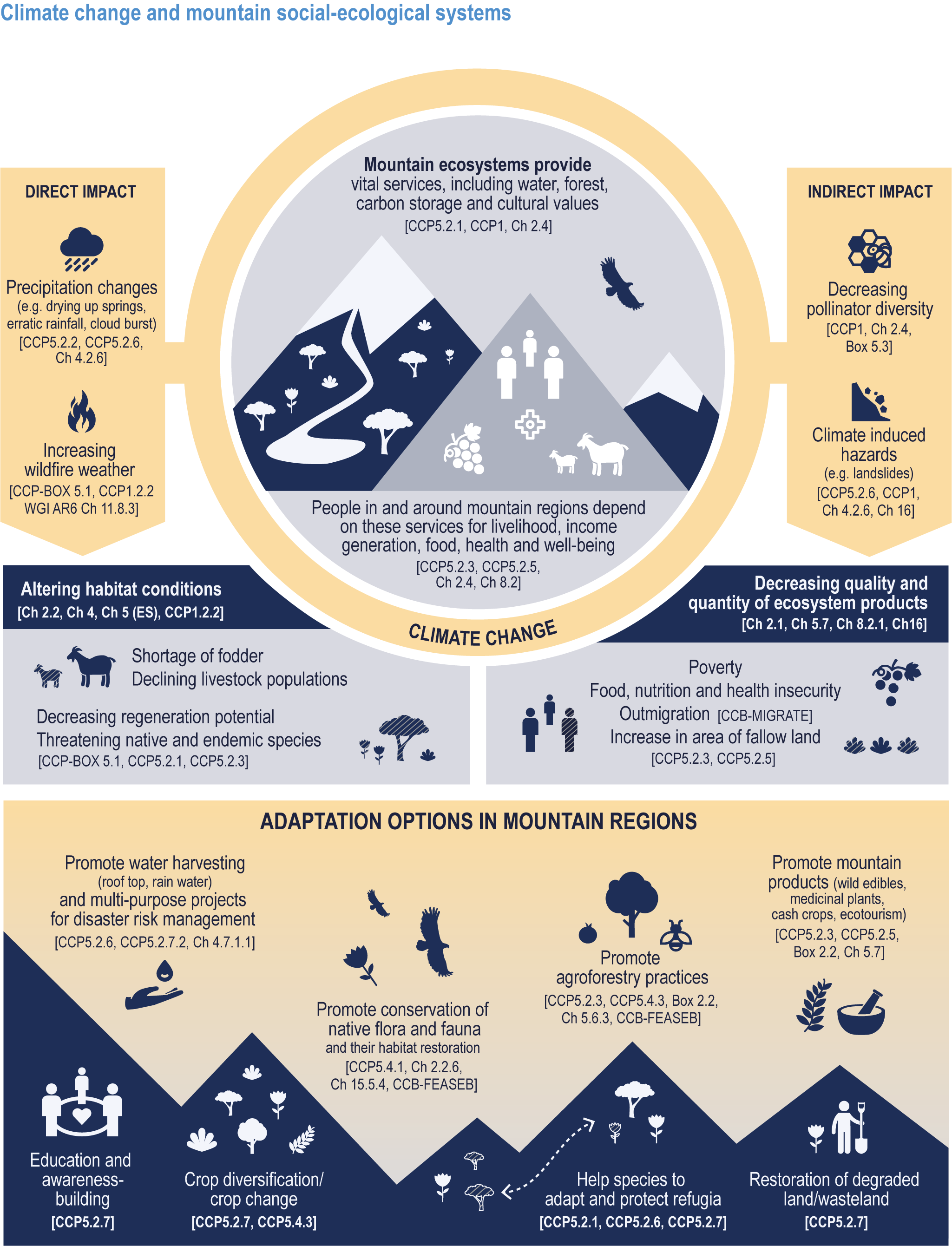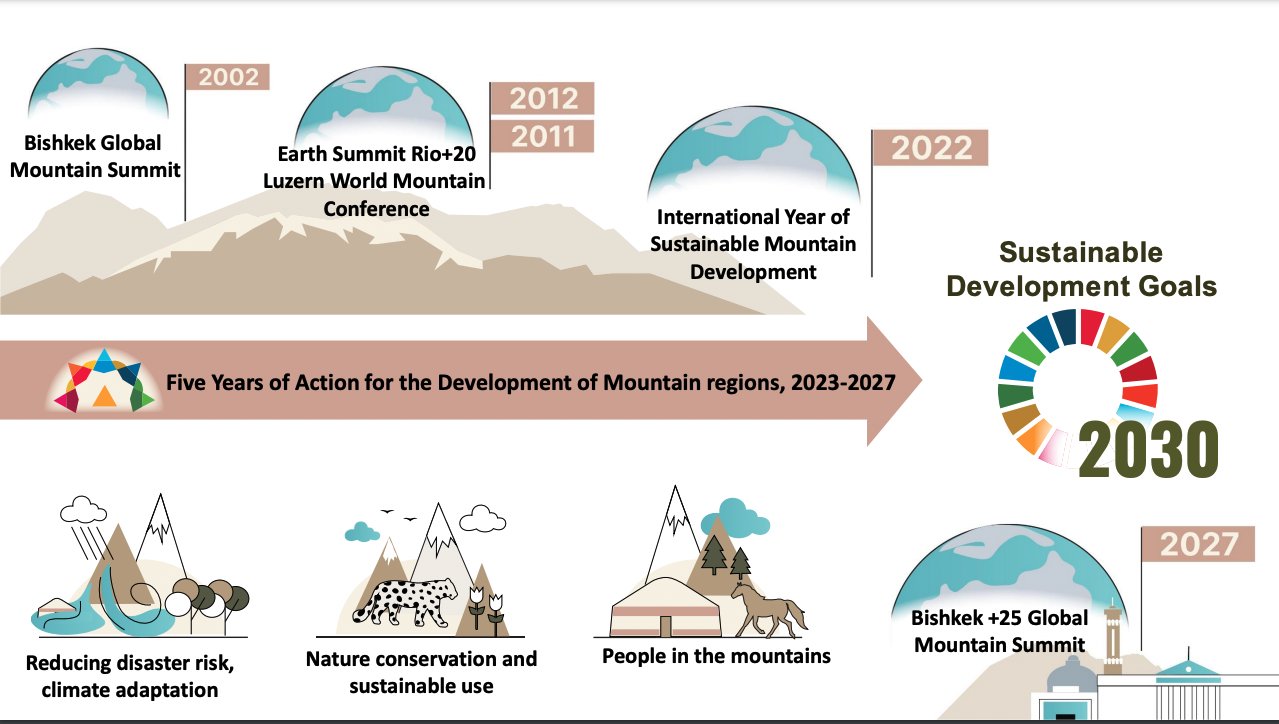Table of contents
Why in the news?
- According to new research published in the journal Nature, species living in 17 mountains around the world may face the risk of extinction due to the rapid rate at which the planet is warming.
- The mountains at significant risk due to global warming included those in the Iran-Pakistan region, Northeast Asia, Brazilian highlands, Western America and Mexico, and the Mediterranean basin.

- In their study, the researchers found these mountain regions to have the highest climate velocity.
- The rate at which "species must move to stay within their survivable habitats".
Let us look into the definition and concept of "Climate Velocity" and its impact on the mountain ecosystem.
Definition
Climate velocity refers to the speed at which suitable climatic conditions for a species are shifting across a landscape due to climate change. It's a metric used by ecologists to understand how quickly a species would need to move to stay within its preferred climate zone.
Concept
- Species and Climate Niche: Every species has a specific range of climatic conditions (temperature, precipitation etc.) that it's adapted to, often referred to as its climate niche.
- Climate Change and Shifting Conditions: Climate change alters these climatic conditions across geographical areas. As temperatures rise and weather patterns change, the suitable zones for many species are literally moving.
- Climate Velocity as a Measure: Climate velocity calculates the rate at which these suitable climate zones are shifting. It's like a speed limit for a species' ideal habitat.

Method of Calculation:
- Gradient-based methods:
- Concept: These methods analyze the spatial and temporal gradients of climate variables.
- Imagine climate variables like temperature or precipitation as surfaces on a landscape, with highs and lows.
- Gradient-based methods calculate the steepness (spatial gradient) and direction of change (temporal gradient) at a specific location.
- Calculation: This typically involves mathematical techniques to analyze how fast and in which direction the suitable climate zone is shifting across the landscape.
- Data: Requires climate data for multiple time periods (historical and future projections) for the relevant climate variables.
- Interpretation: The resulting velocity indicates how quickly the ideal climate for a species is moving at that particular location. Steeper gradients represent faster movement and potentially greater challenges for species to keep up.
- Concept: These methods analyze the spatial and temporal gradients of climate variables.
- Distance-based methods (aka Nearest Neighbor Approach)
- Concept: These methods focus on comparing current climate conditions at a location with future conditions across the landscape.
- They identify the closest match (nearest neighbor) to the current climate in future projections.
- Calculation: The distance between the current location and the nearest neighbor in future climate space is then converted into a velocity by dividing by the time difference between the two climate data sets.
- Data: Requires climate data for both current and future conditions for the relevant climate variables.
- Interpretation: The velocity represents the speed at which a species would need to move to reach its future suitable climate niche.
- Concept: These methods focus on comparing current climate conditions at a location with future conditions across the landscape.

By incorporating climate velocity into conservation planning, we can develop more effective strategies to protect biodiversity in a changing climate.
We can't clear UPSC for you.
But with our personalised mentor support, you'll be ready to do it yourself.
Importance
Climate velocity helps us assess the vulnerability of species to climate change.
- Predicting vulnerability: It helps assess how vulnerable a species is to climate change.
- Scientists can predict if the species can move fast enough to stay within that zone.
- Species with limited mobility or those facing habitat fragmentation are more likely to be negatively affected by rapid climate velocity.
- Conservation planning: Climate velocity allows for targeted conservation efforts.
- Conservationists can focus on protecting areas that could serve as future refuges for species or create corridors to facilitate their movement.
- Additionally, understanding the direction of climate niche movement can help establish corridors to facilitate species migration.
- Prioritizing resources: Conservation resources are often limited.
- Climate velocity helps prioritize which species and ecosystems need the most urgent attention. Focusing on species with high vulnerability due to rapid climate velocity can maximize the impact of conservation efforts.
- Understanding range shifts: It can help predict how the ranges of species might shift in response to climate change.
- This helps identify species that might struggle to migrate fast enough due to factors like limited mobility or habitat fragmentation.
- This information is valuable for managing protected areas, fisheries, and forestry practices that may be impacted by changing species distributions.
- Informing policy decisions: By providing insights into the potential consequences of climate change for biodiversity, climate velocity can help policymakers develop more effective strategies to protect ecosystems and the services they provide.


Impact on Mountain Ecosystems
- Rapid warming: Mountain air temperatures are rising faster than in lowlands. This disrupts temperature-dependent ecological processes, impacting everything from plant and animal life cycles to snow cover and water availability.
- Species struggle to adapt: Many mountain species are adapted to specific temperature ranges. With rapid warming, they may not be able to migrate upslope fast enough to find suitable habitats, threatening their survival and causing biodiversity loss.
- Water disruptions: Melting glaciers and altered precipitation patterns affect the amount and timing of water flow in mountain regions. This can lead to water shortages during critical periods and increased risks of flooding.
- Increased natural hazards: Climate change can trigger more frequent and intense avalanches, landslides, and rockfalls due to thawing permafrost and unstable slopes. These pose a threat to infrastructure, livelihoods, and safety in mountain communities.
- Disruption of ecosystem services: Mountain ecosystems provide crucial services like regulating water flow, storing carbon, and supporting tourism. Climate change disrupts these services, impacting downstream communities and economies reliant on them.
Targeted Conservation Strategies

Protecting Critical Habitats:
- Establishing protected areas: Creating national parks, wildlife sanctuaries, and biomes provides safe havens for vulnerable species and habitats.
- This allows for stricter regulations on activities like grazing, mining, and development that can harm the ecosystem.
- Habitat corridors: Mountain landscapes can be fragmented by human activities or natural features.
- Establishing wildlife corridors allows for easier movement of species between areas, facilitating migration and promoting genetic diversity.
- This can involve restoring degraded land or creating wildlife passages under roads or through development zones.
Species Conservation:
- Species-specific management plans: Developing tailored plans for particularly vulnerable species is crucial.
- This could involve captive breeding programs for endangered animals, reintroduction initiatives, or managing threats like invasive predators.
- Habitat restoration: Restoring degraded habitats like forests or wetlands improves the overall health of the ecosystem.
- This can provide critical resources and shelter for threatened species, allowing populations to recover.
Sustainable Resource Management:
- Sustainable grazing practices: Overgrazing can be a major threat in mountain regions.
- Implementing rotational grazing or limiting livestock numbers helps prevent the degradation of vegetation cover and soil erosion.
- Sustainable forestry practices: Promoting selective logging and reforestation programs ensures the long-term sustainability of forest resources.
- This minimizes the impact on habitats while still allowing for responsible use of timber.
Community Engagement and Empowerment:
- Community-based conservation: Involving local communities in conservation efforts fosters a sense of ownership and promotes long-term sustainability.
- This can involve providing training and resources for sustainable livelihoods or incorporating traditional ecological knowledge into conservation plans.
- Climate-resilient livelihood initiatives: Supporting local communities in adapting to climate change can build resilience and reduce pressure on ecosystems.
- This could involve introducing drought-resistant crops, promoting alternative income sources, and improving disaster preparedness.
Summits and Plans

By implementing a combination of these targeted strategies, conservation efforts can be tailored to address the specific vulnerabilities of each mountain ecosystem.
Previous Post